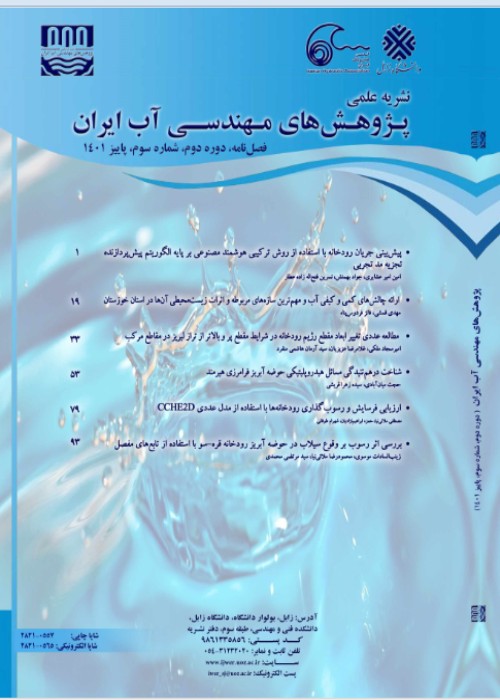Numerical Simulation of Flow over Sharp- and Broad- Crested Weirs with Horizontal and Sloping Crests in a Channel Bend
The main aim of the present study was to simulate flow pattern upstream of sharp- and broad-crested weirs across a 90- degree laboratory channel bend, using the FLOW-3D model. The results indicated that Modeling results were not sensitive to the turbulent mixing length and roughness heights of the channel. Moreover, horizontal crested weirs are sufficient outside the bend. Sloping crest weirs provide better convergence of the unit flow rates across the bend in sections between 30 and 60 degrees. It was proved that the slope of the weir crest is to be in the range of 2º to 5º toward the outer bank of the bend. The broad-crested weirs are superior within the channel bend. Simulation results from the two FLOW-3D and FLUENT models are almost identical for flow patterns around the weirs.
The construction of water structures such as spillways in the longitudinal curvature of rivers is not appropriate (Ayaseh, 2011), and causes the asymmetric distribution of water and sediment flow throughout the river and along the tributary, uneven water load along the river, unbalanced operation of sluices, differences on the left and right banks capacity of the river and problems in the operation stages.There is a long history of flow studies in waterway turns (Chanel and Doering, 2008; Abad and García, 2014). The secondary current in the curvature causes a causal slope in the water surface from the outer arch to the inner arch and lateral pressure across the width, interacts with the non-uniform longitudinal velocity profile, and creates a helical flow in the output area of the bend (Yasi and Valimohammadi Moghim, 2016; Hoseini Mobara and Yasi, 2017).One of the hypotheses to establish a more uniform distribution of flow across the river bend is to change the transverse floor profile to sloping (Abdolahpour, 2010).FLOW-3D has a good capability for modeling complex systems (Chanel and Doering, 2008; Developer of software for computational fluid dynamics (Flow Science Inc.), 2008). Thus, in the present study, it is applied to simulate overflows in a waterway turn and to detect the effects of the inclined crest on the flow pattern.
The FLOW-3D model is capable of simulating the flow of the overflows at the turn of a waterway. This model simultaneously solves the three-dimensional equations of continuity and Navier-Stokes, Eqns 1-2, (11). The model applies the FAVOR leveling method to take into account solid boundary geometry (Fig. 1), and the VOF fluid volume method to simulate the flow with a free surface.Input boundary experiences fixed yield, constant pressure governs output boundary condition, and for the rest of the boundaries, the condition of symmetry was considered. The FLOW-3D model is calibrated and adjusted for three-flow, low-medium, and high-flow conditions based on the results of experimental flow tests in the flume screw interval. The simulation process in the FLOW-3D model is shown in the display process in Fig. 2.In this study, the flow pattern at six cross-sections (upstream, inlet or zero degrees, 30, 60, 90 degrees, and downstream of the turn) were derived, for three states 1) there was a sharp-crest overflow, 2) there was a wide-crest weir, and 3) there was no overflow. The experiments were performed under low (26 liters per second), medium (45 liters per second), and high (58 liters per second) flow.
Ensuring the calibration and validation process of the FLOW-3D model, the results were compared with similar experimental results for 16 sharp-crest weir tests and 16 wide-crest weir tests, also compared with results from the FLUENT simulator model.The results were presented for each of the weir installation sections (in the interval of twice the width of the flume from the upstream of the overflow to twice the width of the flume from downstream of the weir), and for the weir with horizontal and inclined crest. The results show that canal discharge for the state of the installed (sharp or wide-crest) weir is more than for the state where a weir was not installed, Fig. 3. Moreover, it shows that inclined-crest overflows cause discharge distribution per unit width (q) to be more non-uniform across the upstream section control of the weir. Therefore, horizontal-crest overflows (sharp or wide-crest) are more suitable for the upstream section of the curvatures.Fig. 4 indicates that both horizontal-sharp-crest and wide-crest overlays produce a more uniform flow (q) in the initial section (zero degrees). However, the wide-crest overflow performs better, and the sharp-crest overflow increases the discharge intensity toward the outer wall.According to Fig. 5, for the cross-section located at 30°, when there is no overflow the maximum velocity occurs at the inner walls of the bend. Although the flow shows similar behavior where a wide or sharp crest weir was installed, installing a weir decreased the measure of speed changes.Investigation of the effect of overflow on flow pattern at 60° showed that a horizontal-sharp-crest overflow causes to deviate the maximum velocity and consequently discharge to the middle of the weir crest, while the horizontal wide-crest overflow causes the maximum velocity to deviate towards the outer wall, Fig. 6.The flow pattern at 90° (Fig. 7) shows that a horizontal sharp-crest overflow causes to deviate the maximum velocity towards the inner wall, while the horizontal wide-crest overflow deviates it to the middle of the weir crest.
This research simulates an overflow (sharp or wide-crest) in different sections of a 90° bend with FLOW-3D to derive the flow pattern. The results showed that in all cross-sections, the wide-crest weirs have a better performance than the sharp-crest weirs. The horizontal-crest overflow is more effective than an overflow with an inclined crest in the upstream, beginning, end, and downstream cross-sections, although, inclined-canopy overflows distribute the flow more uniformly. Moreover, the flow patterns obtained by both FLOW-3D and FLUENT numerical models are the same and satisfactory, however, the FLUENT model products better the flow velocities in the boundary layer (near walls).


